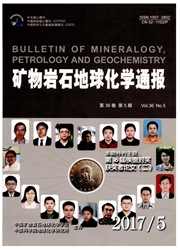

 中文摘要:
中文摘要:
21世纪以来变质岩石学发展迅猛。对大型俯冲带和造山带综合数值模拟研究,所得到的变质作用p-T-t与以往一维热模拟结果很不相同;利用内部一致性热力学数据库,进行变质相平衡的定量研究,改变了人们对变质反应和相平衡关系的理解,开辟了定量研究变质作用的新阶段;超高压变质作用的深入研究,发现了更多超高压变质作用的标志及地体,指示陆壳俯冲深度可能达300~350km,并对地壳岩石深俯冲的机理及变质作用演化进行了进一步探讨;对麻粒岩尤其是高压和超高温麻粒岩的研究,进一步了解了麻粒岩相条件下的深熔作用与熔体演化机理,为认识早前寒武纪的板块作用与造山过程提供了新的窗口;利用多种方法对俯冲带变质流体的研究,为深刻认识俯冲带的岩浆作用及地幔演化提供了更为广阔的视野。
 英文摘要:
英文摘要:
The study of metamorphic petrology has been advanced rapidly during the first decade of the 21st century.For instance,the metamorphic p-T-t paths resulted from the comprehensive numerical model of large-scale subduction and orogenic belts are obviously different from those resulted from the one-dimensional thermal model.Using internally-consistent thermodynamic database,the quantitative study of metamorphic phase equilibria has modified the understanding of metamorphic reaction and phase relations,inaugrating a new stage in the study of metamorphic petrology.The ultra-high pressure metamorphism study has led to more discoveries of ultra-high pressure metamorphic indicators and terranes.There is evidence to support that the subduction depth of the continental crust is up to 300~350 km.Moreover,the mechanism and metamorphic evolution during exhumation of deeply subducted rocks have been elucidated.The study of granulite,especially of high-pressure and ultra-high temperature granulite,has not only facilitated the discussion of partial melting and melt evolution under granulite facies but also provided insights on understanding of the early Precambrian plate tectonics and orogeny.The subduction fluids have been investigated to lead broad discussion of the subduction magmatism and mantle evolution.
 关于魏春景:
关于魏春景:
 同期刊论文项目
同期刊论文项目
 同项目期刊论文
同项目期刊论文
 Metamorphic Evolution of Medium-Temperature Ultra-High Pressure (MT-UHP) Eclogites from the South Da
Metamorphic Evolution of Medium-Temperature Ultra-High Pressure (MT-UHP) Eclogites from the South Da Calculated phase equilibria for MORB compositions: a reappraisal of metamorphic evolution of lawsoni
Calculated phase equilibria for MORB compositions: a reappraisal of metamorphic evolution of lawsoni Metamorphism, anatexis, zircon ages and tectonic evolution of the Gongshan block in the northern Ind
Metamorphism, anatexis, zircon ages and tectonic evolution of the Gongshan block in the northern Ind 期刊信息
期刊信息
